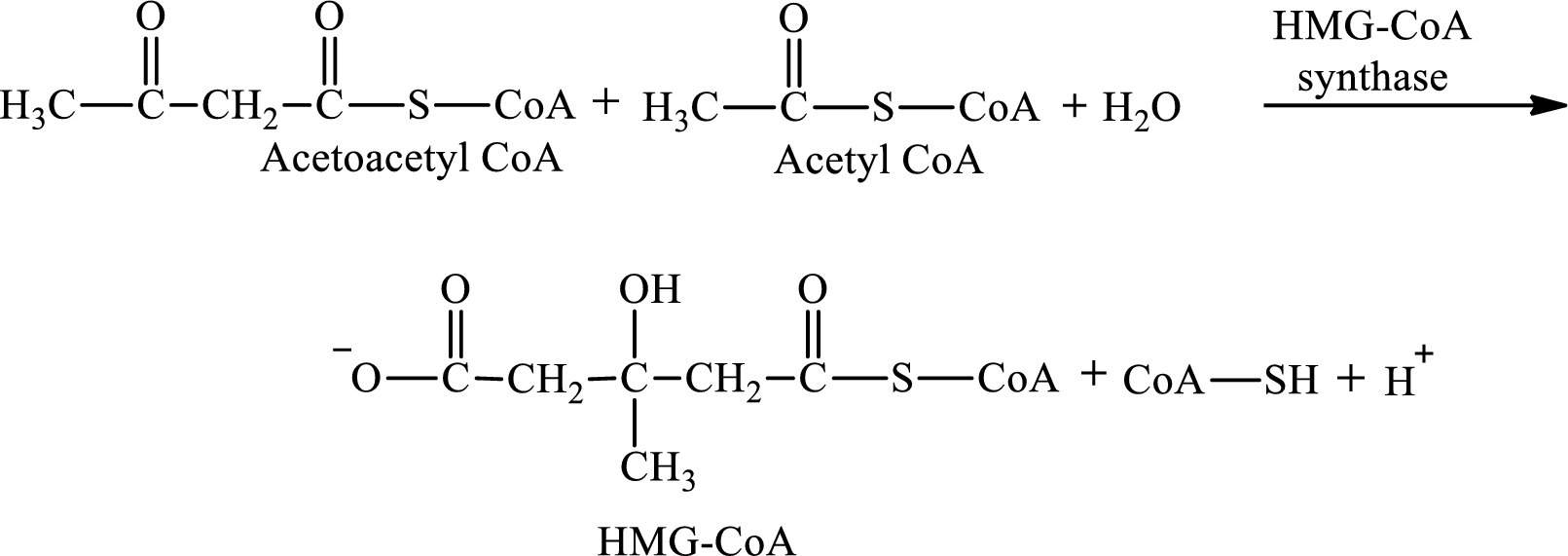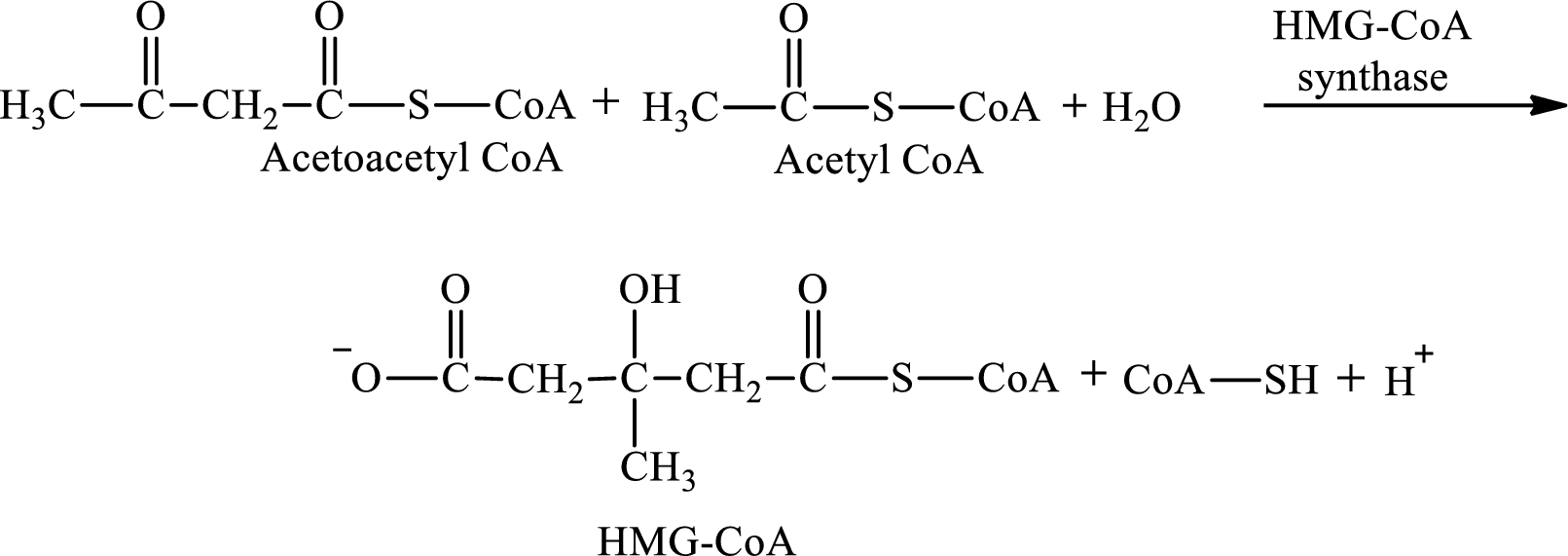
Concept explainers
(a)
Interpretation:
HMG-CoA is encountered in the process (1) glycerol
Concept introduction:
Lipogenesis is the process employed for the synthesis of fatty acid. The starting precursor for the synthesis is acetyl CoA. The enzyme employed for the process is fatty acid synthase. It is a multienzyme complex that ties the reaction responsible for the synthesis of fatty acid. The fatty acid is synthesized in two parts. In the first part, there is citrate-malate shuttle system and in the second part, there is a cyclic process to synthesize saturated fatty acid.
The fatty acids are broken down to provide energy. The breakdown of fatty acids is a three parts process. In the first part, the fatty acid is activated. In the second part, the transportation of fatty acid into the mitochondrial matrix is facilitated by a shuttle mechanism. In the third part, the fatty acid is readily oxidized, cycling through a series of four reactions. In these series of reactions, acyl CoA is degraded to acetyl CoA. This pathway is termed as β-oxidation pathway.
Ketogenesis is a metabolic process by which
Triacylglycerol mobilization is an ongoing process in which triacylglycerols that are stored in the adipose tissue are hydrolyzed. Fatty acids and glycerol are the products of triacylglycerol mobilization. The products are released into the bloodstream.
After entering the bloodstream, the glycerol travels to the kidneys or liver. The first stage of glycerol metabolism occurs in the liver or kidney where it is converted to
(a)
Answer to Problem 25.104EP
HMG-CoA is encountered in ketogenesis.
Explanation of Solution
HMG-CoA is produced in step 2 in ketogenesis.
Step 2 is a condensation reaction. In step 2, acetoacetyl CoA reacts with acetyl CoA and water to produce 3-hydroxyl-3-methylglutaryl (HMG-CoA) and CoA-SH. The reaction for step 2 is:

(b)
Interpretation:
NADPH is encountered in the process (1) glycerol metabolism to dihydroxyacetone phosphate, (2) β-oxidation pathway, (3) ketogenesis, and (4) lipogenesis has to be identified.
Concept introduction:
Lipogenesis is the process employed for the synthesis of fatty acid. The starting precursor for the synthesis is acetyl CoA. The enzyme employed for the process is fatty acid synthase. It is a multienzyme complex that ties the reaction responsible for the synthesis of fatty acid. The fatty acid is synthesized in two parts. In the first part, there is citrate-malate shuttle system and in the second part, there is a cyclic process to synthesize saturated fatty acid.
The fatty acids are broken down to provide energy. The breakdown of fatty acids is a three parts process. In the first part, the fatty acid is activated. In the second part, the transportation of fatty acid into the mitochondrial matrix is facilitated by a shuttle mechanism. In the third part, the fatty acid is readily oxidized, cycling through a series of four reactions. In these series of reactions, acyl CoA is degraded to acetyl CoA. This pathway is termed as β-oxidation pathway.
Ketogenesis is a metabolic process by which ketone bodies are produced by the breakdown of fatty acids and ketogenic amino acids. This metabolic process supplies our organs with needed energy under certain circumstances such as starvation. Fatty acid molecules degrade into acetyl CoA which are utilized as reactants in the process of ketogenesis. These molecules of acetyl CoA undergo the process of condensation twice, followed by chain cleavage and hydrogenation to produce ketone bodies.
Triacylglycerol mobilization is an ongoing process in which triacylglycerols that are stored in the adipose tissue are hydrolyzed. Fatty acids and glycerol are the products of triacylglycerol mobilization. The products are released into the bloodstream.
After entering the bloodstream, the glycerol travels to the kidneys or liver. The first stage of glycerol metabolism occurs in the liver or kidney where it is converted to
(b)
Answer to Problem 25.104EP
NADPH is encountered in lipogenesis.
Explanation of Solution
NADPH acts as the reducing agent in step 2 and 4 of the cyclic process of lipogenesis. NADPH gets oxidized to form NADP+.
Step 2 involves the hydrogenation of acetoacetyl ACP to synthesis β-hydroxybutyrylwith the help of reducing agent NADPH. The reaction of this step is:

Step 4 again involves hydrogenation reaction. In this step, crotonyl ACP is converted to butyryl ACP with the help of reducing agent NADPH. The reaction of this step is:

(c)
Interpretation:
Malonyl ACP is encountered in the process (1) glycerol metabolism to dihydroxyacetone phosphate, (2) β-oxidation pathway, (3) ketogenesis, and (4) lipogenesis has to be identified.
Concept introduction:
Lipogenesis is the process employed for the synthesis of fatty acid. The starting precursor for the synthesis is acetyl CoA. The enzyme employed for the process is fatty acid synthase. It is a multienzyme complex that ties the reaction responsible for the synthesis of fatty acid. The fatty acid is synthesized in two parts. In the first part, there is citrate-malate shuttle system and in the second part, there is a cyclic process to synthesize saturated fatty acid.
The fatty acids are broken down to provide energy. The breakdown of fatty acids is a three parts process. In the first part, the fatty acid is activated. In the second part, the transportation of fatty acid into the mitochondrial matrix is facilitated by a shuttle mechanism. In the third part, the fatty acid is readily oxidized, cycling through a series of four reactions. In these series of reactions, acyl CoA is degraded to acetyl CoA. This pathway is termed as β-oxidation pathway.
Ketogenesis is a metabolic process by which ketone bodies are produced by the breakdown of fatty acids and ketogenic amino acids. This metabolic process supplies our organs with needed energy under certain circumstances such as starvation. Fatty acid molecules degrade into acetyl CoA which are utilized as reactants in the process of ketogenesis. These molecules of acetyl CoA undergo the process of condensation twice, followed by chain cleavage and hydrogenation to produce ketone bodies.
Triacylglycerol mobilization is an ongoing process in which triacylglycerols that are stored in the adipose tissue are hydrolyzed. Fatty acids and glycerol are the products of triacylglycerol mobilization. The products are released into the bloodstream.
After entering the bloodstream, the glycerol travels to the kidneys or liver. The first stage of glycerol metabolism occurs in the liver or kidney where it is converted to
(c)
Answer to Problem 25.104EP
Malonyl ACP is encountered in lipogenesis.
Explanation of Solution
Malonyl ACP is the reactant in step 1 in the cyclic process in lipogenesis.
The first step involves the condensation reaction between acetyl ACP and malonyl ACP. The product formed in the first reaction is acetoacetyl ACP. The reaction of step 1 is:

(d)
Interpretation:
Acetoacetyl CoA is encountered in the process (1) glycerol metabolism to dihydroxyacetone phosphate, (2) β-oxidation pathway, (3) ketogenesis, and (4) lipogenesis has to be identified.
Concept introduction:
Lipogenesis is the process employed for the synthesis of fatty acid. The starting precursor for the synthesis is acetyl CoA. The enzyme employed for the process is fatty acid synthase. It is a multienzyme complex that ties the reaction responsible for the synthesis of fatty acid. The fatty acid is synthesized in two parts. In the first part, there is citrate-malate shuttle system and in the second part, there is a cyclic process to synthesize saturated fatty acid.
The fatty acids are broken down to provide energy. The breakdown of fatty acids is a three parts process. In the first part, the fatty acid is activated. In the second part, the transportation of fatty acid into the mitochondrial matrix is facilitated by a shuttle mechanism. In the third part, the fatty acid is readily oxidized, cycling through a series of four reactions. In these series of reactions, acyl CoA is degraded to acetyl CoA. This pathway is termed as β-oxidation pathway.
Ketogenesis is a metabolic process by which ketone bodies are produced by the breakdown of fatty acids and ketogenic amino acids. This metabolic process supplies our organs with needed energy under certain circumstances such as starvation. Fatty acid molecules degrade into acetyl CoA which are utilized as reactants in the process of ketogenesis. These molecules of acetyl CoA undergo the process of condensation twice, followed by chain cleavage and hydrogenation to produce ketone bodies.
Triacylglycerol mobilization is an ongoing process in which triacylglycerols that are stored in the adipose tissue are hydrolyzed. Fatty acids and glycerol are the products of triacylglycerol mobilization. The products are released into the bloodstream.
After entering the bloodstream, the glycerol travels to the kidneys or liver. The first stage of glycerol metabolism occurs in the liver or kidney where it is converted to
(d)
Answer to Problem 25.104EP
Acetoacetyl CoA is encountered in ketogenesis.
Explanation of Solution
Step 2 is a condensation reaction. In step 2, acetoacetyl CoA reacts with acetyl CoA and water to produce 3-hydroxyl-3-methylglutaryl (HMG-CoA) and CoA-SH. The reaction for step 2 is:

Want to see more full solutions like this?
Chapter 25 Solutions
GENERAL,ORGANIC,+BIO.CHEM.-MINDTAP
- in the scope of the SCH4U course! please show all steps as im still learning how to format my answers in the format given, thank you!arrow_forwardhelp me solve this HWarrow_forwardMolecules of the form AH2 can exist in two potential geometries: linear or bent. Construct molecular orbital diagrams for linear and bent CH2. Identify the relevant point group, include all of the appropriate symmetry labels and pictures, and fill in the electrons. Which geometry would you predict to be more stable, and why? (Please draw out the diagram and explain)arrow_forward
- Indicate the variation in conductivity with concentration in solutions of strong electrolytes and weak electrolytes.arrow_forwardThe molar conductivity of a very dilute solution of NaCl has been determined. If it is diluted to one-fourth of the initial concentration, qualitatively explain how the molar conductivity of the new solution will compare with the first.arrow_forwardWhat does the phrase mean, if instead of 1 Faraday of electricity, Q coulombs (Q/F Faradays) pass through?arrow_forward
- What characteristics should an interface that forms an electrode have?arrow_forwardFor a weak acid AcH, calculate the dissociated fraction (alpha), if its concentration is 1.540 mol L-1 and the concentration [H+] is 5.01x10-4 mol L-1.arrow_forwardIf the molar conductivity at infinite dilution of HAC is A0 = 390.5 S cm² mol¹. Calculate the Arrhenius conductivity of a 9.3% by weight solution of HAc with a pH of 3.3. Data: molecular weight of HAC is 60.05 g/mol and the density of the solution is 1 g/cm³.arrow_forward
- If the molar conductivity at infinite dilution of HAC is A0 = 390.5 S cm² mol¹. Calculate the Arrhenius conductivity of a 9.3% by weight solution of HAc with a pH of 3.3. Data: molecular weight of HAC is 60.05 g/mol and the density of the solution is 1 g/cm³.arrow_forwardIf the molar conductivity at infinite dilution of HAC is A0 = 390.5 S cm² mol¹. Calculate the Arrhenius conductivity of a 9.3% by weight solution of HAc with a pH of 3.3. Data: molecular weight of HAC is 60.05 g/mol and the density of the solution is 1 g/cm³.arrow_forwardDetermine the distance between the metal and the OHP layer using the Helm- holtz model when the electrode's differential capacitance is 145 μF cm². DATA: dielectric constant of the medium for the interfacial zone &r= lectric constant of the vacuum &0 = 8.85-10-12 F m-1 = 50, die-arrow_forward
 Chemistry for Today: General, Organic, and Bioche...ChemistryISBN:9781305960060Author:Spencer L. Seager, Michael R. Slabaugh, Maren S. HansenPublisher:Cengage Learning
Chemistry for Today: General, Organic, and Bioche...ChemistryISBN:9781305960060Author:Spencer L. Seager, Michael R. Slabaugh, Maren S. HansenPublisher:Cengage Learning General, Organic, and Biological ChemistryChemistryISBN:9781285853918Author:H. Stephen StokerPublisher:Cengage Learning
General, Organic, and Biological ChemistryChemistryISBN:9781285853918Author:H. Stephen StokerPublisher:Cengage Learning Organic And Biological ChemistryChemistryISBN:9781305081079Author:STOKER, H. Stephen (howard Stephen)Publisher:Cengage Learning,
Organic And Biological ChemistryChemistryISBN:9781305081079Author:STOKER, H. Stephen (howard Stephen)Publisher:Cengage Learning, Introduction to General, Organic and BiochemistryChemistryISBN:9781285869759Author:Frederick A. Bettelheim, William H. Brown, Mary K. Campbell, Shawn O. Farrell, Omar TorresPublisher:Cengage Learning
Introduction to General, Organic and BiochemistryChemistryISBN:9781285869759Author:Frederick A. Bettelheim, William H. Brown, Mary K. Campbell, Shawn O. Farrell, Omar TorresPublisher:Cengage Learning



